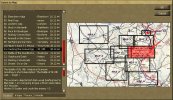While doing these maps, I've been referring to the US Army Green Book The Ardennes:The Battle of Bulge by Hugh Cole. ... Anyway, as I've been skimming through looking for unit locations on specific days at specific times, I find myself actually reading more and more of it. It really is a brilliant book, even if it was written before the Ultra secret came out, the detail is incredible and the maps are awesome.
Yes, I like it very much, too.
It has a few hm.. let me call it downsides, though. The following quote is a piece of a post I wrote in the Matrix BFTB forum in 2012, when Wodin and others suggested to put more detailed statistics in the game, I think:
GoodGuy said:
I think it's more realistic if there are no uber-accurate logs and statistics, as such evaluations were (and partially still are) quite difficult, and because the body count on the ground, after enemy forces had been driven off, would not reveal the whole truth. That was quite obvious during and after the Battle of the Bulge, where the US High Command assessed a way higher efficiency of Allied tactical bombings than was actually achieved. Allied fighter bombers and tactical bombers were credited with killing a certain amount of German Armor, where the actual body count and inspection of the German tanks on the ground revealed that quite some of them had been abondoned and subsequently destroyed by their crews due to lack of fuel, or damaged/destroyed by Allied ground units. Hugh M. Cole addressed this problem in the official Army history partially, but still worked with wrong figures here and there, as quite some German sources were either lost/incomplete or not found, at the time.
A good example of the use of "
wrong figures" (as either German documents were not at hand or were not considered) is PFC Rosenthal's (3rd platoon of the 820th TD Bn that was equipped with M5 AT guns) famous encounter, where the AAR states that Rosenthal sighted 5 German tanks, "
a hostile pillbox" and "
two German-occupied buildings", and that his gun cut right through the Pz.IV tanks at distances of over 500 yards, "
APCR and HE shells causing complete destruction of the tanks, the ammunition truck, the pillbox, and also inflicting 90 casualties on the enemy personnel".
In his book "The Ardennes, 1944-1945", swedish author Christer Bergström contrasts the assessments and collections, based on Allied AAction-Reports, US witness reports (also written ones from captured German officers, who commanded units on either divisional or Korps level) and post battle-analyzis, from Cole with entries found in the war diary of the German II. Abteilung of Panzer-Regiment 16 (Cole considered war diaries, though) AND with additional personal accounts that were not available to Cole or not considered by him, at the time, for example, not just to give the German perspective, but also to assess the (logistical) effect/outcome of particular encounters and the accuracy of Cole's and/or general post-war assessments. The Bn's war diary describes the encounter with the 3rd platoon's gun slightly different, but seems to back up Cole's assessment, regarding the number of knocked out tanks, at least:
"
From an anti-tank position somewhere in the vicinity of Diedrichsborn - Bock, our tanks were exposed to heavy fire. Within a few minutes six tanks are knocked out. The road is blocked. Covered by fire from the pillboxes, the other tanks pull back. Our tanks manage to neutralize 3 anti-tank guns, but our attack had to be cancelled."
So, there were more tanks, plus a 6th tank got knocked out, and troop casualties and the loss of an ammo truck were not mentioned. Cole and McDonald assessed that German tank losses during the first day in that sector amounted to "at least fifteen" or "at least thirteen", respectively. According to Bergström, the divisional commander (of the 116. Panzer-Division) von Waldenburg had a different description of the same event:
"In general the American resistance was weak except in the woods west of Berg where the enemy fought very bravely and fiercely. The commitment of German tanks west of Lützkampen soon forced the enemy to withdraw from his position. Weak enemy harrassing fire was reported from Kesfeld, Uttfeld and Leidenborn and from the road Uttfeld - Leidenborn - Lützkampen .....[ ].
The two assault companies sustained heavy losses. The assault company of the 60. Regt was nearly destroyed, the assault company of the 156. Regt was seriously weakened and joined the regiment the next day. The other losses during the first day were small. Two or three tanks were knocked out by the enemy during the fighting between Lützkampen and Ouren."
If I am not mistaken, Cole pointed out somewhere that a body count (of knocked out tanks) on the ground (after the battle in the Ardennes) had revealed that a way lower percentage of tanks had been knocked out by Allied tactical bombers than the bombing survey or AirForce AARs had assessed, and I am positive that he even mentioned that the Germans were able to repair 7 out of 10 tanks (they had dedicated tank retreivers, some German sources state 7-9 out of 10 tanks), so that only complete wrecks were either left alone or in some cases sent back to the melt to recycle the material.
So, in this case, it's pretty obvious, that of the 6 tanks that got knocked out, 3-4 could be retrieved and repaired.
So, what Cole didn't do, in a number of cases, is to verify the additional German reports, he focused on war diaries and highest echelon witnesses, even though the latter could not produce important details months or years after the offensive.
Given, some of the war diaries got lost, while others remained in German hands, or ended up in German archives, or even in archives in Norway or Sweden, which he probably didn't visit or didn't order to be checked.
That said, for the German perspective, it looks like Cole often depended on reports from divisional or Korps commanders written during their captivity (POW), when war diares were not available, but where then some of these officers either couldn't remember some of the details, or where they omitted details, in order to make them look less "stupid". Also, the entries in the war diaries (where available) described actual events each day, but they (usually) did not report if/when a knocked out tank could be used again. For this info, a historian can check the German monthly actual strength reports showing the number of tanks in the repair shop, which might not reveal the complete picture, though, as some (field) repairs just took 5-12 hrs, or just several days, so that these tanks would not appear in the "under repair"-section of the monthly report, so that some of these tanks may even look as parts of new allocations/deliveries. For this case, the allocation msg or a notice of receipt would have to be checked, too. That's a level of research Cole either couldn't or didn't want to do.
Btw, a prominent instance of a "creative" strength report was the report filed by SS-Panzer-Aufklärungs-Abteilung 9 HQ (9th SS-Recon Bn of the 9th SS-Panzer-Division), as it reported many vehicles "unserviceable" and/or "under repair", to avoid an ordered handover of their vehicles and EQ.to the 10. Panzer-Division.
Bergström has his own explanation for the differences between the German Bn's war diary and von Waldenburg's description regarding the amount of losses: He stresses that the daily reports in the war diaries were usually written on the same day, so that numbers referring to the number of knocked out tanks and vehicles did (or could) not include the number of repairable tanks/vehicles. He also emphasizes that another "important explanation" for the "general American exaggeration" of German tank losses may be the fact that German tanks (especially Panther or Tiger tanks) "often managed to withstand frontal hits from many U.S. weapons, without being significantly damaged - hits that would have destroyed any American tank. In the heat of the battle it is understandable that American gunners assumed that they destroyed a German tank that they scored a direct hit on."
I really recommend that book, it gives some interesting insights regarding the German moves, but also about both sides' intelligence failures and tactical mistakes.
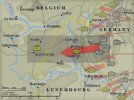
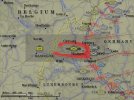
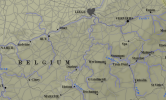

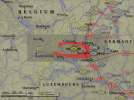
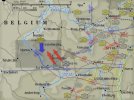
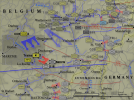
It's about 8 mouse clicks a map to do, so it won't take too long to do.
I wasn't happy with the fonts, as they weren't sharp enough for my liking, so I changed them. Much happier now.
